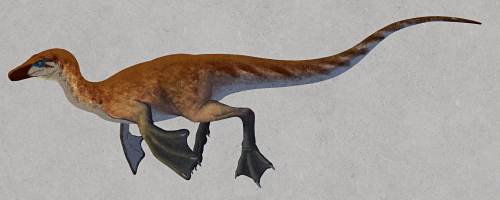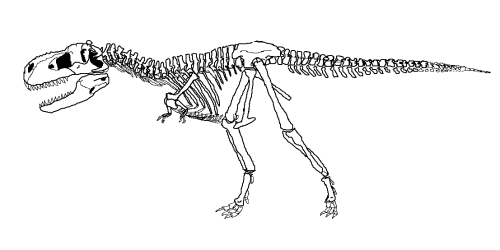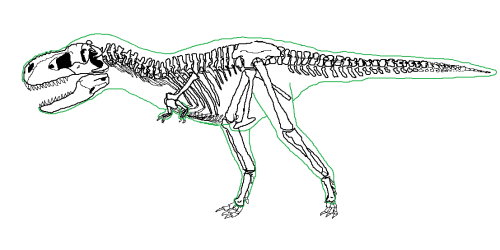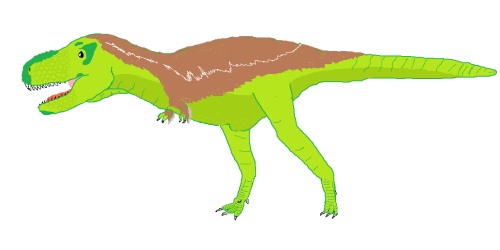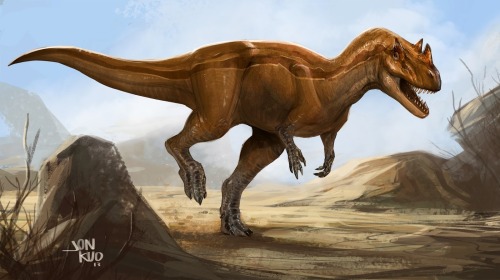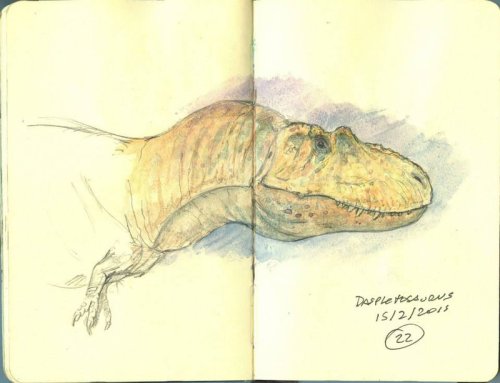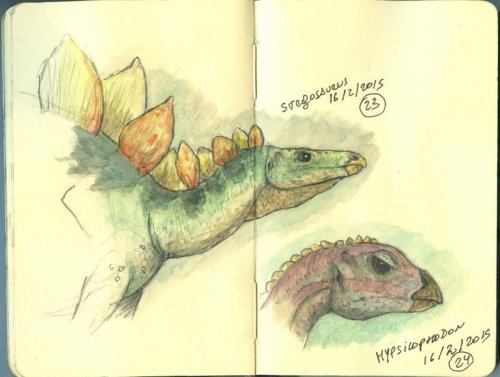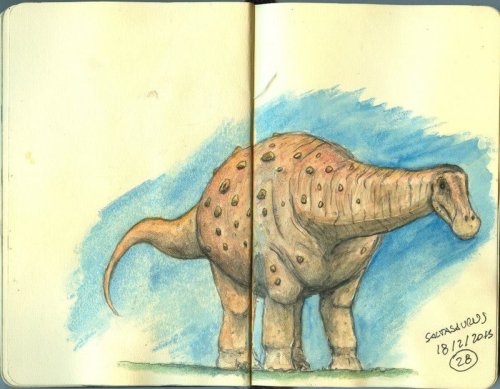#theropod






Dinosaur Fancier t-shirts
Like most paleonerds, you probably have a favorite type of dinosaur. Maybe you are a fan of theropods, maybe you are more into sauropods or maybe you are more of a ceratopsian person. No matter what sort of dino you prefer we’ve got you covered! Choose one of out t-shirts and let us know what you fancy.
sulc.us/fancy
Designs by David Orr


Spinosaurus unisex sweatshirt
Have you heard about the newest Spinosaurus paper? It suggests that Spino may have been able to swim after all!
Design by @grecovia


Bird Evolution sweatshirt
A fun pattern showing some of the stages in the evolution of non-avian theropod dinosaurs into full fletched birds. Can you spot the transition?
Coelurosauria > Maniraptora > Paraves > Eumaniraptora > Euavialae > Ornithothoraces > Aves.
Design by Greco Westermann
April Fools 2022: The Aquatic Dinosaur That Wasn’t
So,Spinosauruswasn’ttechnically the first known aquatic non-avian dinosaur.
That title instead temporarily went to Compsognathus corallestris.
While the idea that hadrosaursandsauropods were wallowing swamp-dwellers had been completely abandoned at the start of the Dinosaur Renaissance, the new view of dinosaurs as active sophisticated animals led to a surprising aquatic hypothesis during the early days of this paleontological revolution.
A specimen of the small theropod Compsognathus discovered in southeastern France in the early 1970s was only the second skeleton ever found of this dinosaur, and came over a century after the first. It was initially thought to represent a new species since it was about 50% larger than the German specimen of Compsognathus longipes, and it seemed to have something very unusual going on with its hands – its forelimbs were somewhat poorly-preserved and distorted, and had traces of some sort of large fleshy structure around the hands that was interpreted as representing elongated three-fingered flippers used for swimming.
This wasn’t necessarily as ridiculous of an idea as it might sound. Compsognathus lived during the Late Jurassic, about 150 million years ago, at a time when Europe was a group of islands in a shallow tropical sea. A semiaquatic dinosaur specialized to swim and dive, hunting the abundant aquatic prey in its environment, and easily able to island-hop all around the European archipelago seemed at least somewhat plausible, and reconstructions of fin-handed C. corallestris even appeared in several popular dinosaur books of the time.
But it didn’t last.
Within just a few years doubt was being cast on this idea, and further studies of both known Compsognathus skeletons in the late 1970s and early 1980s concluded that C. corallestris was actually a fully-grown adult individual of the juvenile C. longipes. The French Compsognathus had normal-looking hands for its kind after all, with two large clawed fingers and a vestigial third finger, and the “flipper” impressions had just been ripples in the fossil slab.
For a long time after that the general view became that there just weren’t any aquatic non-avian dinosaurs at all – but more recent discoveries like the new Spinosaurus material and Halszkaraptor are starting to suggest that some of these animals were much more at home in the water than previously thought.
Something resembling Compsognathus corallestris might still surprise us in the future.
———
Nix Illustration|Tumblr|Twitter|Patreon
Post link
Retro vs Modern#23:Spinosaurus aegyptiacus
Spinosaurid teeth were first found in the 1820s in England, but were misidentified as belonging to crocodilians. It wasn’t until nearly a century later that Spinosaurus aegyptiacus was discovered and recognized as a dinosaur – and it would be another century after that before we really started to learn anything about it.
1910s
The first fossils of Spinosauruswerediscovered in Egypt in the 1910s. With only a few fragments of its skeleton known it was an enigma right from the start, hinting at a large and very strange theropod dinosaur with crocodile-like teeth, an oddly-shaped lower jaw, and elongated neural spines on its vertebrae that seemed to be part of a huge sail.
A few possible extra fragments were found in the 1930s, but overall these few pieces were all that was known of Spinosaurus for a long time.
The fossils were kept in the Paleontological MuseuminMunich, Germany,a building that was severely damaged during a bombing raid in World War II. Many important specimens were destroyed, including Spinosaurus, and only the published drawings and descriptions of the bones remained.
So for the next several decades Spinosaurus remained a very poorly-understood mystery. During this period it was generally depicted as a generic “carnosaur”, often modeled on something like Megalosaurus, in the standard-for-the-time tripod pose and with a Dimetrodon-like sail on its back.
Interestinglya 1930s skeletal reconstructionshowsSpinosaurus with an unusually long torso and fairly short legs, details that are surprisingly modern despite the retro posture.
1990s
In the 1980s some partial snout bones from Niger were recognized as having similarities with the jaw of Spinosaurus. Around the same time the fairly complete skeleton of Baryonyx was discovered, and along with further spinosaurid discoveries in the mid-to-late 1990s a decent idea of what Spinosaurus might have looked like began to emerge.
It was reconstructed with a long kinked crocodilian-like snout, a ridged bony crest in front of its eyes, an S-curved neck, and large thumb claws on its hands – an interpretation that was heavily popularized by Jurassic Park III in the early 2000s, bringing this enigmatic dinosaur to public attention and portraying it as a fearsome super-predator bigger than Tyrannosaurus.
2020s
Despite attempts to locate more complete Spinosaurus remains, only fragments continued to be found, and it remained a frustratingly poorly-known species even into the early 2010s.
Finally, in 2014, almost a full century after it was first described and named, Spinosaurus started to reveal its secrets with the announcement of the discovery of the most complete skeleton so far, discovered in the Kem Kem fossil bedsinMorocco. Its body was still only partially represented, but it included skull fragments, part of a hand, a complete leg and pelvis, some sail spines, and several vertebrae from the neck, back, and tail.
And nobody was expecting what these pieces revealed.
It had a very long torso and proportionally short stumpy legs, and was reconstructed with a huge distinctive “M-shaped” sail on its back. Its feet had flat-bottomed claws and its “dewclaw” toe was enlarged into an extra weight-bearing digit – adaptations for spreading its weight over soft muddy ground, and suggesting its feet may also have been webbed. Initially it was also presented as possibly being quadrupedal, due to how far forward its center of mass seemed to be, reviving an odd idea from the late 20thcentury.
Along with its long crocodile-like head and conical teeth, this was interpreted as evidence it was a semiaquatic fish-eating swimming animal – potentially making it the first known semiaquatic non-avian dinosaur. Spinosaurids had been suggested to be specialized piscivores before, especially since Baryonyx had been found with fish scales in its stomach, but they were generally assumed to be more like modern grizzly bears, wading into water to hunt but not being habitual swimmers. Spinosaurus’ weird croco-duck proportions, however, seemed like they might be much more suited to watery habitats than to the land.
SinceSpinosaurus had become a popular dinosaur with the general public by that point, the discovery was big news – and a big controversy for a while. It was so bizarre that some paleontologists were skeptical of the radical new interpretation, wondering if the measurements of the skeleton were correct or if the short legs were even from the same individual or the same species as the rest of the bones.
After a while the new proportions were accepted as fairly accurate, and over the next few years attention turned to instead figuring out just how this animal worked and how aquatic it actually was. An earlier isotope analysis of its teeth supported a semiaquatic lifestyle similar to crocodiles and turtles, but a buoyancy study argued that it might not have been able to dive below the water suface and its sail made floating unstable – but also found that its center of mass was closer to its hips than previously calculated, suggesting it could walk bipedally after all.
Then in 2020 came another surprise: more of the tail of the new specimen had been found, and it was just as weird as the rest of Spinosaurus. Its tail was a huge vertically flattened paddle-like fin supported by long thin neural spines and chevrons, resembling a giant eel or newt more than a dinosaur and also giving some more weight to the idea that it was a swimmer.
Our modern view of Spinosaurus is still evolving, and likely to be full of even more surprises in the future as we discover more about this unique dinosaur. But we at least know it lived in what is now North Africa during the Late Cretaceous, about 99-93 million years ago, and whether it was a swimmer or wading generalist predator it was one of the largest known theropods to ever live, estimated to have reached around 16m long (~52ft).
While the “M-shaped” sail reconstruction has been popularized by the recent discoveries, the exact shape of this structure is still unknown. Like with other sailbacked animals it’s also not clear what it was for, with ideas including temperature regulation, visual display, supporting a fatty hump, and a potential hydrodynamic adaptation.
EDIT: And while I was working on this entry (late March 2022) I missed that another study had just come out with more anatomical support for swimming Spinosaurus!
———
Nix Illustration|Tumblr|Twitter|Patreon
Post link
Modern birds’ upper beaks are made up mostly from skull bones called the premaxilla, but the snouts of their earlier non-avian dinosaur ancestors were instead formed by large maxilla bones.
AndFalcatakely forsterae here had a very unusual combination of these features.
Living in Madagascar during the Late Cretaceous, about 70-66 million years ago, it was around 40cm long (1'4") and was part of a diverse lineage of Mesozoic birds known as enantiornitheans. These birds had claws on their wings and usually had toothy snouts instead of beaks, and many species also had ribbon-like display feathers on their tails instead of lift-generating fans.
Falcatakely had a long tall snout very similar in shape to a modern toucan, unlike any other known Mesozoic bird, with the surface texture of the bones indicating it was also covered by a keratinous beak. But despite this very “modern” face shape the bone arrangement was still much more similar to other enantiornitheans – there was a huge toothless maxilla making up the majority of the beak, with a small tooth-bearing premaxilla at the tip.
This suggests that there was more than one potential way for early birds to evolve modern-style beaks, and there may have been much more diversity in these animals’ facial structures than previously thought.
———
Nix Illustration|Tumblr|Twitter|Patreon
Post link
New Carnivorous Dinosaur Unearthed in Argentina
http://www.sci-news.com/paleontology/maip-macrothorax-10765.html
Post link
Hi everyone, hope you’re all staying safe and staying indoors during this pandemic!
I had a go at drawing a Tyrannosaurus rex skeleton in Paint (I based it on lots of different drawings and photos of skeletons I saw, but the one I used the most is the Nation’sT. rex at the Smithsonian. The leg stance is my own, so palaeotumblr, let me know if that’s anatomically impossible!)
After that I decided to have a go at giving it a body. I hope I didn’t make it too shrink-wrapped?
Palaeoartists - feel free to give me a critique so I can improve for next time!
A few things I opted to include, along with sources linked:
- Feathers on the back and arms, but nowhere else.
- Lips. Enamel has been found preserved on theropod teeth, which needs to be kept wet. Crocodilians live in water so don’t need lips, but theropods may have.
- Crocodile-like integument on the face.
- Neck ribs and gastralea (stomach ribs), which are delicate, hard to mount and often missing from museum skeletons!
- Keratinised facial features are from this Your Dinosaurs Are Wrong video.
- I tried to make it obvious that the eyes face forward, the hands are supinated, not pronated, and the feet are digitigrade - common mistakes in beginner dino art!
Possible mistakes I can see already, palaeotumblr let me know!
- The tail looks way too thin to be an effective counterweight to that huge head, should it be thicker?
- More keratin on the lachrymal than just that little eyebrow-like ridge?
- Would the feathers stop there, or would they plausibly extend all the way down the dorsal side of the tail? I know the ventral side was scaly as we have impressions for that.
- The teeth need to be more obviously heterodont, but that’s hard to draw in Paint!
Post link



And here’s the companion piece to the Baryonyx, the Suchomimus! This was heavily inspired by the design from Warpath: Jurassic Park, which I really dig (even if its head is literally a Bary head reused from the Lost World PS1 game). The designs here include (left to right, top to bottom) the default Warpath Sucho, the Jurassic Park Institute Sucho based on art by Timothy J. Bradley, and the maxed out Sucho from Jurassic Park Builder.
I may do more of these in the future, but the next piece will be only tangentially related. It has more to do with Bary than Sucho.



After a lot of work over what should have been a whole lotta “eh”, here are some “dossiers?” “readouts?” of Baryonyx drawn in the Jurassic Park art style. This is a fun one especially since you can compare and contrast it with the existing Jurassic World Baryonyx to get an idea of how those movies design creatures differently.
Enjoy! Another one of these will be shared tomorrow.

The “Prologue” for Jurassic World Dominion (that short IMAX preview from this summer) is finally out on Youtube, so I drew up a Dominion-ish Giganotosaurus to celebrate.
Idk if the Paleostreams by Joschua Knüppe have much presence on here, but they’re basically Twitch streams where people draw & chat about extinct animals and paleoart together.
Here are some drawings I did yesterday and then made a lot prettier. Animals from top to bottom are:
Edops (attempting to mate)
Utahraptor (preening on a rock)
Ebrachosuchus





Here it is, the final Jurassic June piece. And, instead of going for a baby, I gave the existing baby T. rex an edgy teen phase!
This juvenile T. rex is based on Jane, the fossil specimen argued to be a juvenile T. rex(orNanotyrannus to some). This makes the animal a lot more sleek and lithe, perfect for fast pursuits before it turns into a chunky tankbuster.
Enjoy and hope you’ve had fun this month!


Baby JP Compsognathus for Jurassic June! This is based on a mish-mash between animals like SinosauropteryxandCoelophysis, mostly due to the fact that the animal’s name changed during production. I imagine these would be super soft like a kitten, and not potentially ravenous like the adults. A real gamble for a cute pet in a post-Fallen Kingdom world.
I expect I can get 2 more done for the month, and I think they’re interesting subjects. Enjoy!

Yesterday was crazy busy, too busy to focus on drawing. So I colored instead! It took a little less focus and was a little more relaxing
This was one of my Dinovember pages. He is smol and has flashy arm fluffs Based on sunbitterns



